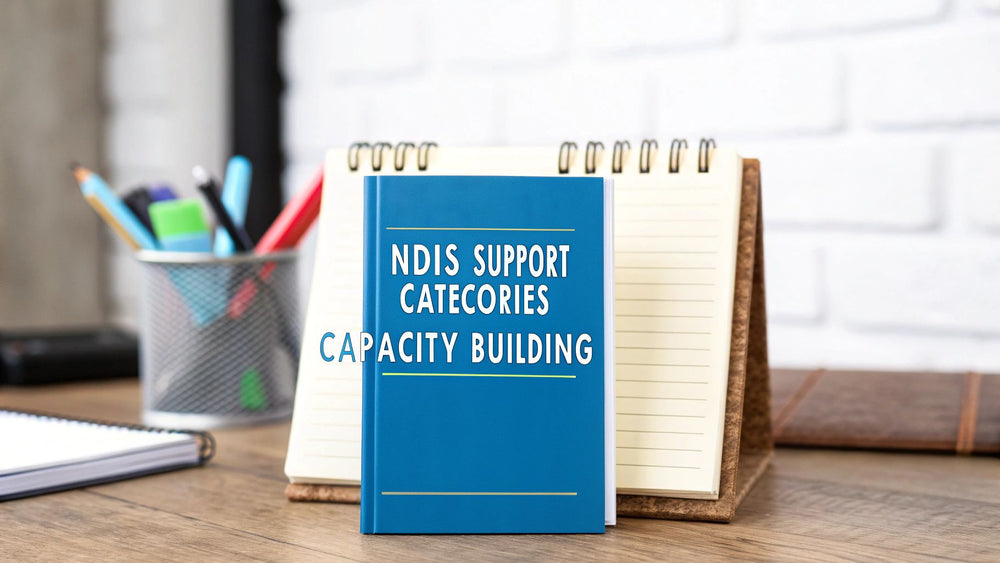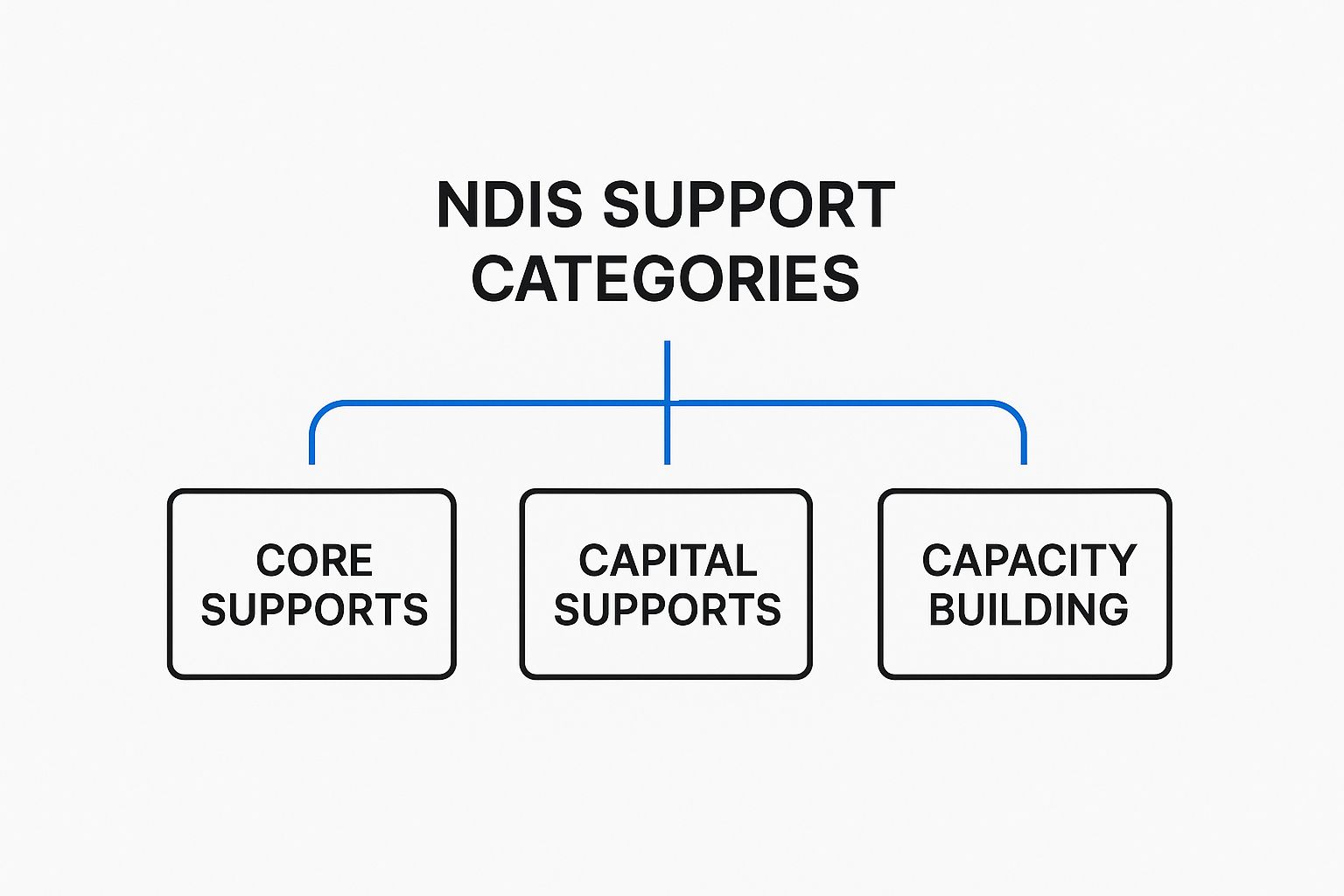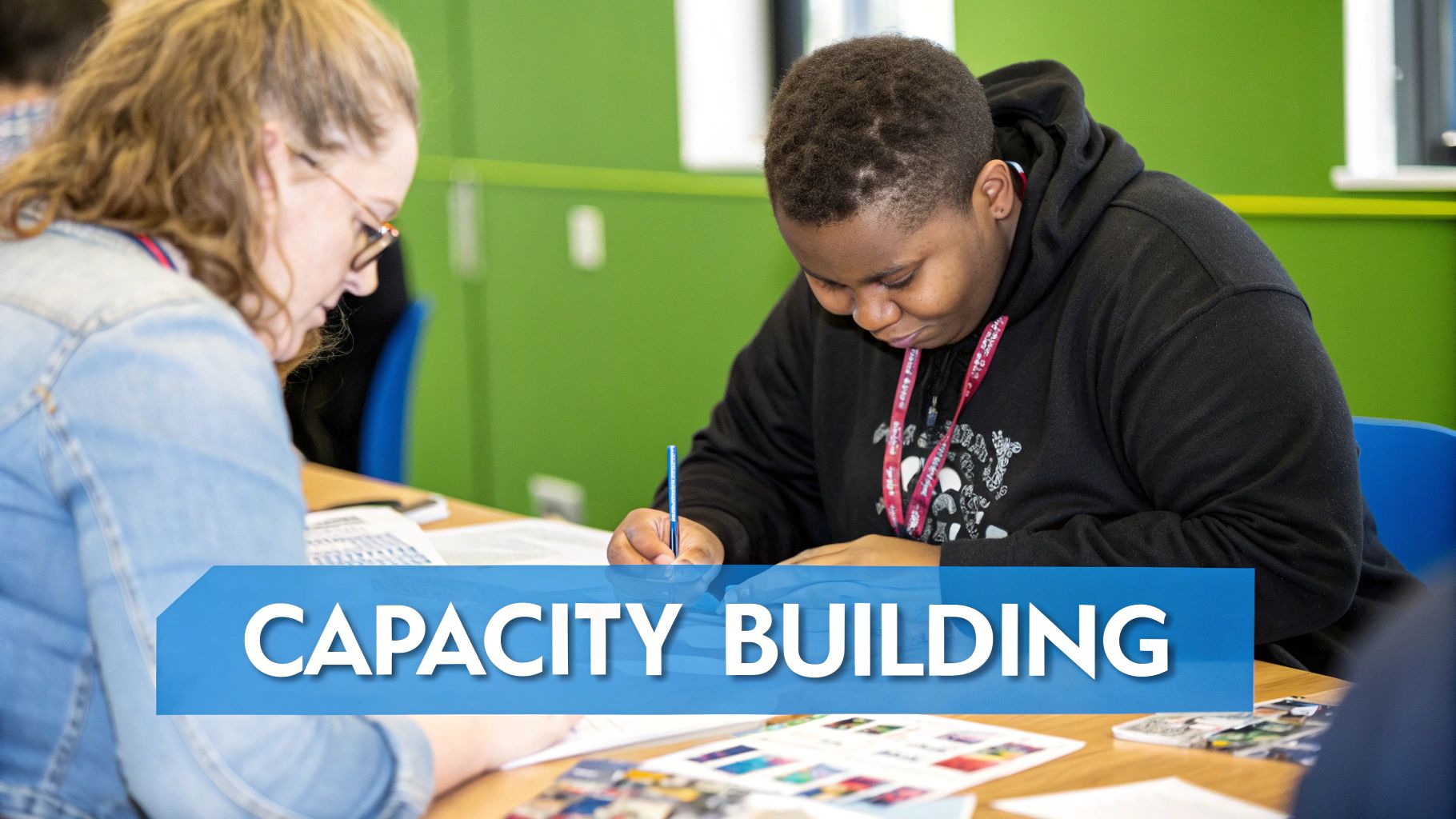Your Guide to NDIS Support Categories

When you first open your NDIS plan, it can feel a bit overwhelming. With all the different terms and sections, knowing where to start isn't always obvious. But once you get past the new language, you’ll find the entire plan is built on a simple, logical foundation.
At its core, your NDIS plan is organised into three main budget categories: Core, Capital, and Capacity Building. Each one has a distinct job to do in helping you live the life you want.
Think of it like setting up your own home.
- Core Supports are your everyday essentials. This is the flexible funding for things you need to manage your daily life, like getting help with personal care or transport.
- Capital Supports are the big-ticket items. This budget is for major investments that improve your access and independence, such as assistive technology or modifications to your home.
- Capacity Building is all about personal growth. This funding helps you learn new skills and build your independence for the long term, whether that’s through therapy or finding a job.
This structure helps ensure your funding covers your immediate needs while also paving the way for your future goals.

With over 600,000 Australians in the scheme as of early 2025, the NDIS has a massive reach. While the average funding package sits around $70,000 per year, every plan is tailored to the individual. Yours is designed around your specific needs, circumstances, and what you want to achieve.
If you’re based in South Australia, our guide to navigating the NDIS in Adelaide can give you more localised insights.
Before we explore each category in detail, let’s quickly summarise the three budgets. Think of this table as a handy cheat sheet you can refer back to as you get more familiar with how your plan works.
The Three NDIS Support Budgets at a Glance
| Budget Type | Primary Purpose | Example Supports |
|---|---|---|
| Core Supports | Funding for everyday activities and daily living needs. | Support worker for personal care, transport to appointments, consumables. |
| Capital Supports | Funding for one-off, high-cost equipment or modifications. | Wheelchairs, vehicle modifications, bathroom rails, assistive technology. |
| Capacity Building | Funding to develop skills and increase independence over time. | Therapy sessions (OT, physio), employment support, learning to cook. |
Getting a firm grasp of these three areas is the first step toward using your NDIS plan effectively. It allows you to see your plan not just as a source of funding, but as a clear roadmap connecting your daily needs with your future ambitions.
Now, let's break down each of these budgets one by one.
Using Core Supports for Your Everyday Needs

Think of your Core Supports budget as the practical, everyday part of your NDIS plan. It’s designed to be the most flexible funding you receive, covering the essentials that help you with daily activities, get out into your community, and live more independently.
What’s great about Core Supports is its adaptability. In most cases, you can move funding between its various categories to respond to what you need, when you need it. This gives you genuine choice and control over your daily life and social activities.
The NDIS groups all supports into 15 specific categories across three main budgets: Core, Capital, and Capacity Building. For most people, Core Supports make up the bulk of their plan—often around 70% of the total budget. This really shows how vital this funding is for achieving your day-to-day goals.
Assistance with Daily Life
This is one of the most significant and widely used categories in any NDIS plan. It’s all about funding the hands-on, practical help you need to manage personal activities and household tasks, right where you live.
For instance, you might arrange for a support worker to visit in the morning to help you get ready for the day. This could look like assistance with personal care, making breakfast, or simply organising what you need for work or an outing. The entire focus is on building a routine that supports your independence at home.
If you're based in South Australia, finding a provider who really understands your needs is key. Our guide on choosing the right disability support in Adelaide can walk you through how to make a great choice.
Transport
Getting around is fundamental to connecting with people, attending appointments, and just enjoying a full life. This category provides funding to help you travel if your disability makes it impossible to use public transport without significant difficulty.
This funding can be used in a few different ways:
- Booking taxis or ride-share services to get to social events or medical appointments.
- Using specialised transport services that are properly equipped for your accessibility needs.
- Contributing to the cost of a support worker using their own vehicle to drive you to activities.
Consumables
This is your budget for purchasing the everyday items you need specifically because of your disability. Think of it as the fund for all those low-cost products, equipment, and other essential supplies that make life easier.
The Consumables budget is brilliant because it covers the tangible, everyday items that make a real, practical difference. It gives you the power to buy things like continence products or simple assistive technologies that directly help you manage your day.
Common examples of what you can buy include:
- Continence products.
- Specialised nutritional formula or supplements.
- Low-cost assistive technology, such as sensory items or aids for personal care.
Assistance with Social and Community Participation
This funding is all about helping you build relationships and get involved in activities you love. It’s designed to break down the barriers that might stop you from joining in with social events or recreational hobbies.
You could use this funding to pay for a support worker to accompany you to a local sports club, help you attend a weekly art class, or even just make it easier to visit friends and family. It’s your ticket to a more active and connected life.
Investing in Your Future with Capital Supports
While Core Supports take care of your everyday needs, the Capital Supports budget is all about making significant, long-term investments in your independence. Think of it as funding for the big-ticket items that can fundamentally change how you live in your own space, making everything safer and more accessible.
These items generally come with a higher price tag and are built to last for years, often reducing your reliance on other supports down the track. This budget is much less flexible than your Core budget and is broken down into two main NDIS support categories: Assistive Technology and Home Modifications.
Because these are such substantial investments, the funding is almost always 'stated'. This is just NDIS-speak for "earmarked". It means the money has been allocated for a very specific item or service and can't be shifted to anything else. You'll usually need to get quotes from suppliers to have these supports approved in your NDIS plan.
Understanding Assistive Technology
Assistive Technology (AT) is a broad term for any piece of equipment or device that helps you do something you otherwise couldn't, or simply makes a task easier and safer to manage. This category covers an incredible range of items, from simple, everyday aids to highly complex, custom-built solutions.
For instance, your AT funding might cover:
- A custom power wheelchair so you can get around your community on your own terms.
- A voice-activated smart home system that lets you control lights, doors, and the thermostat without assistance.
- Specialised software that opens up new ways for you to communicate, work, or learn.
At its heart, AT is about giving you the right tools to break down physical and environmental barriers, putting you back in control and offering a new level of freedom.
Creating an Accessible Home
The other half of the Capital budget is for Home Modifications. This funding is specifically for making structural changes to your house, so you can live there more safely and move around more easily. It’s all about shaping your environment to work for you, not against you.
A well-planned home modification is more than just a renovation; it’s a pathway to greater independence at home. Installing a simple ramp or redesigning a bathroom can eliminate daily obstacles, boosting confidence and safety in your most personal space.
Some common examples we see include:
- Installing ramps for wheelchair access at the front or back door.
- Modifying a bathroom with grab rails, a walk-in shower, or an accessible toilet.
- Widening doorways to make room for a wheelchair or walker.
If you're thinking about home modifications, getting a handle on the potential costs is a crucial first step. Reading a detailed house renovation cost breakdown can really help you plan effectively. Ultimately, these investments empower you to be more involved in family life and better connect with the world outside your door—a key goal we dive into in our article on how community participation NDIS funding works.
Building Skills Through Capacity Building Supports

If Core Supports cover your day-to-day needs and Capital Supports handle big-ticket items, then Capacity Building is all about investing in you. This is the part of your NDIS budget that's laser-focused on your future, helping you build new skills, boost your independence, and make real progress towards your long-term goals.
Unlike the flexible Core budget, Capacity Building funds are structured differently. They are allocated across nine specific support categories, and you generally need to use the funding within its assigned category. It’s a purposeful approach designed to help you build the exact abilities you need to live a more autonomous and fulfilling life.
This is where your aspirations take centre stage. The funding here gives you the resources to turn 'I want to' into 'I can'.
Driving Your Independence
The nine categories under the Capacity Building umbrella cover a huge range of personal and professional growth areas. They're designed to help you master new skills that truly matter to you, whether that's managing daily life more easily or landing a job you love.
Let's break down a few key areas to see how they work in the real world.
-
Improved Living Arrangements: This is all about finding and keeping a home that's right for you. You could use this funding to work with an occupational therapist to explore different housing options, like Supported Independent Living (SIL), and figure out which one is the best fit for your needs and goals.
-
Increased Social & Community Participation: While your Core budget might pay for transport to get you to an activity, this category helps you build the skills to join in with confidence once you're there. This might mean funding therapy to develop your social skills or hiring a mentor to help you settle into a new community group.
-
Finding & Keeping a Job: Think of this as your personal employment toolkit. The funding can cover a wide range of supports to help you enter the workforce, such as a job coach to polish your resume, practice interview skills, or even provide on-the-job training as you find your feet in a new role.
The real power of the Capacity Building budget is its focus on empowerment. It's not just about providing support for today; it's about equipping you with the skills and confidence to need less support tomorrow.
A Deeper Look at the Categories
To really get the most out of your plan, it's crucial to understand what each of the nine categories is for. Each one has a specific purpose aimed at helping you achieve your goals.
The table below breaks down each category and the kind of goals it's designed to help you achieve.
Capacity Building Categories and Your Goals
| Capacity Building Category | Primary Goal and Skill Development |
|---|---|
| Support Coordination | Helps you understand and use your plan, connect with providers, and manage your budget effectively. |
| Improved Living Arrangements | Supports you in finding and maintaining appropriate housing and developing skills for independent living. |
| Increased Social & Community Participation | Assists you in building skills to participate in community, social, and recreational activities. |
| Finding & Keeping a Job | Provides employment support, from pre-employment skill-building to on-the-job assistance. |
| Improved Relationships | Now often called Behaviour Support, this helps you develop positive behaviours and build better relationships. |
| Health & Wellbeing | Supports you in managing your health, including exercise physiology and personal training to improve fitness. |
| Improved Learning | Assists you in transitioning from school to further education, like TAFE or university. |
| Improved Life Choices | Covers plan management services, helping you manage your NDIS funds and pay providers. |
| Improved Daily Living | Funds therapeutic services like occupational therapy, speech therapy, and psychology to build your skills. |
As you can see, each category targets a different area of skill development.
For many participants, the Improved Daily Living category is a cornerstone of their NDIS plan. It provides access to allied health professionals who can deliver targeted therapies to improve how you manage everyday life. To get a complete picture of this vital area, you can explore a detailed guide on NDIS Capacity Building and see how all these supports can work together. Understanding this helps you see how these services build the foundation for greater independence.
Making Your NDIS Budget Work for You
Getting your NDIS plan approved is a massive achievement. But the real power comes when you learn to steer your funding yourself. When you know how to use your budget effectively across the different support categories, you can make genuine, lasting progress towards the life you want to live.
A big piece of this puzzle is deciding how your funds will be handled.
There are three main paths you can take to manage your NDIS funding. The best one for you really comes down to how hands-on you want to be.
- NDIA-Managed (or Agency-Managed): This is the most straightforward route. The National Disability Insurance Agency (NDIA) pays your providers directly from your plan's budget. The main trade-off is that you're limited to using only NDIS-registered providers.
- Plan-Managed: Here, you partner with a plan manager, who acts as your financial go-between. They take care of paying invoices and managing the paperwork for you. This is a popular choice because it gives you the flexibility to use both registered and non-registered providers, striking a great balance between support and freedom.
- Self-Managed: As the name suggests, you're in the driver's seat. You manage your funds, pay your providers, and keep track of your spending yourself. This option gives you the ultimate level of control and flexibility over your supports.
Getting your head around these choices is the first step in making sure your funding truly works for you and your goals.
Tracking Your Funds and Planning Ahead
Once you've picked a management style, keeping a close eye on your spending is crucial. It’s easy to think overspending is the only problem, but consistently underspending can also cause issues. It might suggest to the NDIA during a plan review that you don't actually need the level of funding you have.
Actively tracking your budget puts you in control. It shows you exactly where the money is going and helps you see if you're actually using all the supports you've been approved for. If you notice funds in a certain category are going untouched, it might be a good time to request a plan review to shift that funding to where you need it most.
Don't be afraid to use the flexibility within your Core budget. If you save money on transport one month, you can often reallocate those funds to another Core category, like community participation, to pursue a new hobby or social activity. This is your budget to control.
Let's be honest, navigating the system isn't always a walk in the park. Systemic issues can sometimes create roadblocks. For instance, in 2023-24, more than 30% of carers reported hitting barriers like poor service coordination and frustratingly long waiting lists. You can dive deeper into these challenges by reading the Productivity Commission's latest report.
Knowing about these potential hurdles isn't meant to discourage you; it's about being prepared. It allows you to plan ahead with your support coordinator or plan manager to find ways around them. Building confidence in managing your budget is what empowers you to adapt and make sure your plan keeps working for you, no matter what comes your way.
Common Questions About NDIS Support Categories

Once you start digging into the different NDIS support categories, it’s completely normal for a few practical questions to pop up. Getting your head around these details is the best way to feel confident and make informed choices about your support.
Let’s walk through some of the most common queries we hear from participants and their families.
Can I Use Funding From One Support Category in Another?
This is a great question, and the answer really shows how flexible your plan can be—but with some important rules.
Think of your Core Supports budget as your most adaptable pool of money. In most cases, you have the freedom to move funds between its four sub-categories: Assistance with Daily Life, Transport, Consumables, and Social & Community Participation.
So, if you end up saving a bit on your Transport budget one month, you could absolutely redirect that money to pay for a support worker to join you for a community outing. It’s all about letting you respond to your needs as they change.
On the other hand, your Capital and Capacity Building budgets are much stricter. These funds are locked in. Money allocated for a specific Capital item, like a custom wheelchair, or a Capacity Building activity, like therapy sessions, must be used for that exact purpose.
What Happens If I Don’t Use All My Funding?
It’s crucial to know that any unused NDIS funds simply disappear at the end of your plan period—they don't roll over. Your budget resets, and your new plan will be based on your current needs and goals.
If you consistently have a lot of money left over in a category, the NDIA might see this as a sign that you don't need that much funding. This could lead to a smaller budget in your next plan.
Using your funds effectively is key to demonstrating your ongoing need for support. If you're struggling to use your budget, it's a signal to talk to your support team, not a reason to let the funds go to waste.
This is exactly why actively using your plan is so important. If you find you aren't spending your funds, it's a good idea to reach out to your plan manager or support coordinator. They can help you brainstorm ways to use your supports to get you closer to your goals. For more on this, check out our article on maximising your NDIS plan with support coordination.
How Do I Add a New Support to My Plan?
Life changes, and your goals might evolve, meaning you could need a new support that wasn't included in your original plan. To make this happen, you'll typically need to go through a plan review or what’s called a plan variation.
The key to getting a new support approved is providing solid evidence that it is 'reasonable and necessary'. This usually means collecting reports and assessments from professionals like an Occupational Therapist, psychologist, or other specialists who can back up your request.
For example, if you wanted to add funding for 'Improved Living Arrangements', you'd almost certainly need a detailed assessment from an OT. Their report would explain exactly how this support helps you work towards greater independence and achieve the goals you've set out in your plan. Armed with that evidence, you can request a review with the NDIA.
At Vana Care, we know that truly understanding the nuts and bolts of NDIS support categories is what empowers you to use your plan to its full potential. We're here to provide personalised, human-first support that helps you build confidence and live life on your terms. Find out how our dedicated team can help you in Adelaide and regional South Australia by visiting us at https://www.vanacare.com.au.


